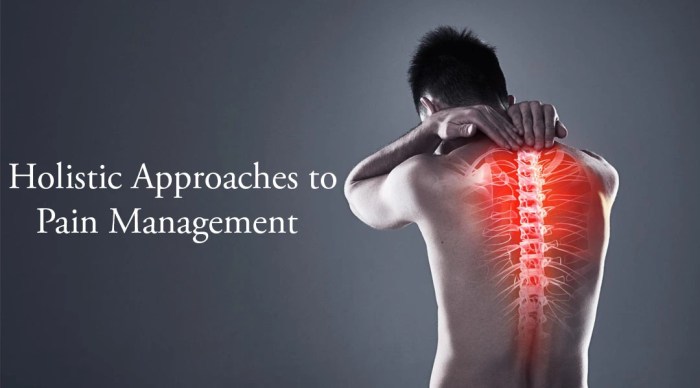
Welcome, dear pain warriors! If you’ve ever felt like your body is staging a rebellion, you’re in the right place. Prepare to dive into the whimsical world of Holistic pain relief, where acupuncture needles are your allies, yoga mats become your battlefields, and herbal teas might just have magical powers. Yes, we’re talking about an approach that’s not just about tossing back painkillers like candy but embracing a cornucopia of mind-body techniques that may just leave you pain-free and grinning like the Cheshire Cat.
From the ancient art of acupuncture to the soothing hands of massage therapy, we’ll explore how integrating mindfulness practices like yoga and meditation can transform your pain experience. Coupled with the mighty powers of nutrition and physical therapy, you’ll discover that relief can come from places you never thought to look—like your kitchen or the yoga studio down the street!
Holistic Approaches to Pain Relief
In the quest for pain relief, many individuals are turning to holistic techniques that embrace the mind, body, and spirit. This approach is like a harmonious orchestra, where each instrument plays its part to create a soothing symphony of well-being. Whether you’re feeling like a pretzel after a bad fall or just want to release those pesky knots that seem to have multiplied overnight, holistic methods offer a variety of options that can get you back to your happy dance.Holistic techniques for pain management are not just your run-of-the-mill solutions.
They involve a combination of therapies that aim to treat the whole person rather than just the symptoms. From the ancient art of acupuncture to the soothing touch of massage therapy, there’s a treasure trove of options to explore. Here’s a closer look at some of the most effective holistic approaches to alleviating pain.
Acupuncture and Its Benefits
Acupuncture, a key player in the holistic showdown, employs fine needles to stimulate specific points on the body, promoting natural healing and pain relief. This ancient Chinese practice can be compared to a GPS for your energy pathways, directing the flow of chi to areas that need a little extra love and attention.
- Reduced Chronic Pain: Numerous studies have shown acupuncture to be effective in reducing chronic pain conditions such as arthritis, back pain, and migraines. Treatment can provide significant relief, allowing patients to live their lives without feeling like they’re trapped in a never-ending episode of “Pain Olympics.”
- Better Sleep: Acupuncture can help regulate sleep patterns, making it easier to drift off into dreamland instead of counting sheep. After all, who wouldn’t want to replace insomnia with restful slumber?
- Stress Relief: This therapy acts like a warm hug for your nervous system, reducing anxiety and promoting relaxation—all while you lie back and let someone else poke you with needles. It’s the ultimate “you deserve it” experience.
Massage Therapy and Tension Release
Massage therapy is like a magic wand, gently coaxing those tight muscles to release their grip on your sanity. With various techniques ranging from Swedish to deep tissue, massage therapists are like the modern-day wizards of relaxation.
- Increased Circulation: A good massage not only makes you feel like jelly but also improves blood circulation, which can aid in healing and reduce inflammation. Think of it as a freeway for your blood cells, zooming towards areas that need repair!
- Enhanced Flexibility: Regular massages can improve your flexibility and range of motion, making you feel like a youthful acrobat instead of a rusty tin man.
- Mental Clarity: The relaxation that follows a massage can lead to improved focus and mental clarity. You’ll be solving puzzles and strategizing like a chess champion in no time!
Chiropractic Care for Structural Alignment
Chiropractic care focuses on aligning the spine and optimizing the body’s biomechanics, which can feel like a refreshing reboot for your skeletal system. When your spine is happy, the rest of your body tends to follow suit.
- Pain Relief: Chiropractors use adjustments to alleviate pain in the back, neck, and joints. Many patients experience immediate relief, like cracking open a can of soda after a long day—refreshing!
- Improved Posture: Regular visits can lead to better posture, which not only helps in reducing pain but also makes you look taller and more confident. Who knew standing tall could be so therapeutic?
- Holistic Health Monitoring: Chiropractors often provide lifestyle advice, encouraging patients to engage in healthier habits like proper nutrition and exercise. It’s like having a personal trainer who also knows how to realign your spine!
Mind-Body Practices: Yoga and Meditation
Integrating mind-body practices such as yoga and meditation can be a game-changer in the realm of pain relief. These practices are not just for zen masters; they’re accessible to anyone looking to alleviate pain and find their inner calm.
- Yoga for Flexibility and Strength: Yoga combines physical postures with breathing techniques to improve strength, flexibility, and balance. It’s like a gentle workout that makes you feel like you’ve given your muscles a gentle hug.
- Meditation for Pain Management: Meditation helps cultivate mindfulness, allowing practitioners to manage their perception of pain. With practice, you can learn to observe pain without becoming overwhelmed by it—like watching a movie instead of being part of it.
- Stress Reduction: Both practices promote relaxation and stress relief, which can significantly reduce muscle tension and chronic pain. It’s like sending your stress packing on a one-way trip to a deserted island.
Herbal Remedies and Nutritional Supplements
In addition to therapies, herbal remedies and nutritional supplements can play a vital role in pain relief. These natural options are like nature’s little helpers, providing support without the side effects often associated with pharmaceuticals.
- Ginger: Known for its anti-inflammatory properties, ginger can be consumed as tea or added to meals. It’s like giving your body a warm, spicy embrace!
- Turmeric: Curcumin, the active ingredient in turmeric, has powerful anti-inflammatory effects. Use it in cooking or as a supplement; it’s not just for curry anymore!
- Omega-3 Fatty Acids: Found in fish oil, these acids have been shown to reduce joint pain and stiffness. They can make you feel as smooth as a dolphin in the ocean!
Embracing holistic approaches to pain relief allows individuals to regain control over their wellness journey, turning pain into power and discomfort into dance.
Health and Nutrition’s Role in Pain Management
When it comes to tackling pain, many people think of pills and potions, but it’s time to flip the script and let food take the spotlight. Believe it or not, the dinner plate can be just as powerful as the medicine cabinet! Throughout history, our ancestors knew a thing or two about using their diets to combat discomfort, and modern science is now catching up, confirming that what you eat can influence inflammation and chronic pain levels.
So, grab your forks and knives; let’s chew on some serious information!Chronic pain and inflammation may not be the best of friends, but guess what? Your diet can play the role of the peacemaker! The foods you consume can either fan the flames of inflammation or help extinguish them. A diet rich in processed foods and sugar can lead to higher levels of inflammation, while whole, nutrient-dense foods can work wonders for your body.
Studies have shown that certain food components, such as omega-3 fatty acids found in fish, antioxidants from fruits and vegetables, and fiber from whole grains can help reduce inflammation and ultimately ease pain. So, it turns out that eating your veggies might just be your secret weapon against chronic discomfort!
Popular Diets and Their Impacts on Pain Relief
Several popular diets have emerged as champions in the quest for pain relief, and they all have their unique spin on eliminating inflammation. Below are some diets that can help you kick pain to the curb:
- Mediterranean Diet: This diet is like a Mediterranean vacation for your taste buds! With a focus on fruits, vegetables, whole grains, olive oil, nuts, and fish, it packs a punch of omega-3s and antioxidants. Studies have shown that it can significantly reduce markers of inflammation.
- Anti-Inflammatory Diet: Think of this as a superhero diet. It encourages foods like turmeric, green tea, berries, and leafy greens, all known for their anti-inflammatory properties. A study revealed that participants following this diet reported a notable decrease in pain levels.
- Paleo Diet: Going back to our caveman roots, this diet emphasizes whole foods while ditching processed items. By consuming lean meats, fish, fruits, and veggies, followers may experience a reduction in inflammation and pain. It’s like eating like a rock star—before they had to worry about gluten!
Incorporating specific nutritional strategies can bolster your overall health while helping to manage obesity-related pain. Excess weight can put unnecessary strain on your joints, making a healthy diet and weight management a priority. Here are some effective strategies to consider:
- Portion Control: Sometimes, less truly is more. Being mindful of portion sizes can help you keep your weight in check while allowing you to enjoy a variety of foods without overindulging.
- Fiber-Rich Foods: Foods high in fiber, such as fruits, vegetables, legumes, and whole grains, can help you feel full longer and prevent overeating. Plus, they’re great for your digestive health!
- Hydration: Don’t underestimate the power of water! Staying hydrated can help reduce inflammation and keep your joints lubricated. Aim for at least 8 glasses a day, or more if you’re feeling parched!
- Mindful Eating: Paying attention to what you eat and savoring each bite can help reduce stress and lead to healthier food choices. It’s a win-win for your mood and your waistline!
“Let food be thy medicine, and medicine be thy food.” – Hippocrates
Physical Therapy and Personal Training for Pain Relief

In the quest for pain relief, physical therapy and personal training join forces like a dynamic duo of health heroes. Think Batman and Robin, except instead of capes, they wear stretchy pants and have a treasure trove of exercises up their sleeves. Whether you’re dealing with a pesky backache or chronic joint pain, the right combination of movements can be your golden ticket to feeling fabulous once again.Physical therapy isn’t just about passive treatment; it’s a proactive approach to reclaiming your body.
With the right exercises, patients can regain strength, flexibility, and confidence—without needing a degree in rocket science. Personal trainers, on the other hand, can customize workout plans that cater specifically to the needs of clients dealing with chronic pain, ensuring that they move effectively and safely. This collaboration hinges on understanding proper biomechanics and posture, essential tools in the toolbox for both therapists and trainers alike.
Specific Physical Therapy Exercises for Pain Relief
Certain exercises stand out as champions in the realm of pain relief. Here’s a whimsical yet informative look at some specific physical therapy exercises designed for various conditions:
Gentle Stretching
For a tight neck, try chin tucks. Sit tall, and bring your chin towards your chest while looking slightly up to the ceiling. Hold for a few seconds and repeat. Picture yourself as a giraffe trying to look over a fence—graceful and slightly ridiculous.
Strengthening Your Core
The bridge exercise is perfect for back pain. Lie on your back, knees bent, feet flat on the floor. Lift your hips while squeezing your glutes. Think of it as a mini-lift-off for a rocket ship—your glutes being the powerful engines.
Range of Motion
Ankle pumps can relieve heel and ankle pain. While lying down, flex and point your toes. Imagine you’re a ballerina practicing her best moves, only you’re in your living room with your cat as your audience.
Water Therapy
If you have access to a pool, water exercises can reduce stress on joints while providing resistance. Picture yourself as a mermaid, gliding through the water effortlessly. These exercises can be easily modified based on individual pain levels and needs. Always consult a healthcare provider before jumping into a new routine; we don’t want you to turn into a human pretzel!
Guide for Personal Trainers on Customizing Workout Plans
When it comes to personal training, customizing workout plans for clients with chronic pain is like crafting a bespoke suit—everything should fit just right. Here’s a guide to ensure trainers hit all the right notes when tuning into their clients’ needs:
Initial Assessment
Begin with a thorough assessment to understand the client’s pain history, limitations, and goals. This is the “getting to know you” part, where you might even share your favorite snacks.
Set Realistic Goals
Collaborate to set achievable goals. Emphasize progress over perfection, because nobody wants to feel like an Olympic athlete on their first day.
Incorporate Low-Impact Exercises
Focus on low-impact moves such as cycling, swimming, or using an elliptical machine. These activities offer a workout without the jarring impact of running away from your problems.
Modify and Communicate
Be flexible in your approach. If an exercise causes pain, modify it or substitute it with an alternative. Always keep the lines of communication open—encourage feedback, so adjustments can be made.
Educate on Body Mechanics
Teach clients about proper biomechanics and body alignment to prevent further injury. Imagine you’re a wise old sage sharing the secrets of the universe—well, at least the universe of movement.
Importance of Proper Biomechanics and Posture
Understanding proper biomechanics and posture can be a game-changer in managing pain. It’s like discovering the cheat code to your body’s video game. When our bodies are aligned correctly, we minimize stress on joints and muscles, allowing for smoother movements and less discomfort.
Optimal Alignment
Maintaining proper posture while sitting or standing distributes weight evenly across the body. Picture a tower of blocks; if one block is off-center, the entire structure can topple over.
Movement Patterns
Engaging in proper movement patterns reduces the risk of overuse injuries. Think of it as learning the choreography to your favorite dance; without the right moves, you might end up stepping on toes—yours or someone else’s.
Strength and Flexibility
Strengthening weak muscles and increasing flexibility can aid in maintaining proper posture. It’s like your body’s way of saying, “Watch out world, I’m ready to strut my stuff!”Incorporating physical therapy exercises and personalized training strategies can empower individuals to manage pain effectively. With the right knowledge and a sprinkle of humor, the journey to relief can be less daunting and much more enjoyable.
Wrap-Up

So there you have it, intrepid explorers of holistic healing! We’ve traversed the landscape of pain relief, unveiling the secrets of acupuncture, the magic of herbal remedies, and the wonders of nutrition and exercise. Remember, your journey to a pain-free existence doesn’t have to feel like a chore; it can be an adventure filled with laughter, discovery, and maybe a few awkward yoga poses.
Embrace the holistic path to pain relief, and you’ll not only find comfort but perhaps even a newfound joy in the journey of feeling fabulous!
Helpful Answers
What exactly is holistic pain relief?
It’s like assembling a team of superheroes to fight pain—using a blend of physical, nutritional, and mental techniques!
Can I really manage pain without medication?
Absolutely! With the right holistic strategies, you might just kick those pills to the curb.
Is yoga really effective for pain relief?
Yes, yoga is like a magic potion for your muscles, helping to stretch and strengthen while calming the mind.
How soon can I expect results from holistic methods?
Results can vary, but many feel better within a few sessions. Patience is key—good things come to those who wait!
Are herbal remedies safe for everyone?
Not necessarily! It’s best to consult with a healthcare professional to ensure they’re right for you.







